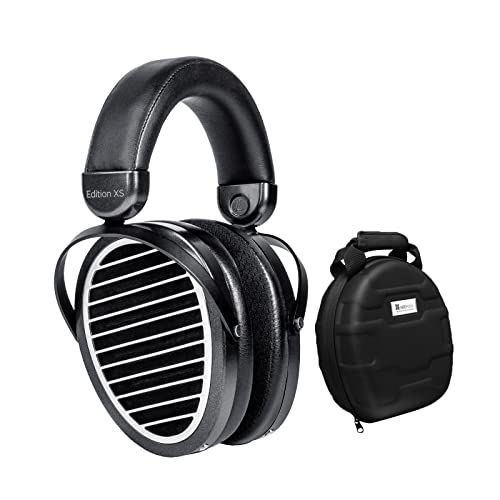how do planar magnetic headphones work In-Ear Headphones
Planar magnetic headphones (also called orthodynamic or isodynamic) have earned themselves a reputation in the audiophile community due to their incredible detail and high-quality bass.
They also tend to leak outwards, so they require a quiet listening space. They may disturb others around you. However, they can offer excellent sound quality at a reasonable cost.
Open or closed back?
Planar magnetic headphones are a popular choice among audiophiles, and it's clear why. The best models offer amazing clarity and a powerful presence without sounding distorted. However, these headphones can be expensive and typically require a headphone amplifier in order to power them. They also leak sound and let in ambient noise. So if you're in the market for a pair of headphones that are planar, you'll need to think about your preferences and listening habits prior to making a purchase.
The best place to begin is to determine if you'll be using your headphones for casual listening or audiophile-grade audio. You should also think about your personal preferences and whether you prefer a closed-back or an open-back design.
Planar magnetic headphones have always had an advantage in the bass department compared to dynamic driver headphones, as they can reproduce frequencies to around 20hz. Dynamic driver headphones roll off at about 50hz. However, this difference has become less pronounced as manufacturers have tried to improve the quality of their diaphragms, and make the rest of the headphones lighter.
Many affordable planar magnetic headsets focus on clarity and highs and mids instead of the bass that is deep. These headphones might not have as much a punch and rumble, which can be a problem to some listeners.
HiFiMAN's Venus headphones are a standout. They feature a closed back design and a diaphragm which is only one-sided. As a result, they aren't as deep, but still have a deep sub-bass, and a surprisingly engaging texturing.
The kind of headphones you choose will ultimately depend on your listening habits as well as your budget. If you're going to be listening to music on your laptop at home and have an open-back pair, an open-back pair headphones with a planar design will likely be the best choice for you, while a closed-back pair is suitable for use when you're on the move. If you plan to use your headphones for gaming, an open-back version like the Audeze LCD-2 Classics may be superior to a model with a closed-back design like the HiFiMan Susvara 2020. If you're a music lover then any of these headphones will provide the entire audio spectrum and incredible detail you're after.
Response to bass
Planar magnetic headphones produce sound using a distinct technique than traditional dynamic driver in ear monitors (IEM). Instead of one magnet pushing the diaphragm, these headphones employ two magnetic fields sandwiched between an electric film. This results in a more wide sound wavefront that is more natural with lower distortion. This also allows for a faster response time and a greater frequency range than traditional dynamic drivers.
The difference in bass response is evident. While high-end dynamic driver headphones can reach up to 20hz and beyond, most planar headphones can go deeper with less distortion and better clarity. For audiophiles, this makes huge difference and offers the best listening experience you can get.
Imaging is another way that planar headphones can enhance sound quality. Dynamic drivers vibrate only the diaphragm part that is attached to the voice coil. This can cause small distortions that alter the audio reproduction. Planar drivers on the other hand, can produce an even larger soundstage because their entire diaphragm is vibrating when an audio signal is received. This allows the headphones to precisely reproduce the position, stereo balance, and the transparency of instruments as it was intended by the audio producer.
Open-back planars like the HIFIMAN Anaanda and Monoprice Monolith M1070 are not able to isolate sound. Anyone around you will be able to hear your music. This is a small price to pay for the incredible clarity and clarity you'll be able experience.
The leakage of headphones in planar models is greater than open-back dynamic ones due to the fact that they have two magnetic fields that are at odds. This can be an issue for those who want to listen in a quiet environment or are concerned about disturbing other people. If you are worried about leakage, there are solutions to address this issue, for instance the ear pads that wrap around the ears to provide isolation.
Sensitivity
Planar headphones are distinct from traditional dynamic drivers with a speaker dome or cone behind which the voice coil is moving. They have thin membranes that are imprinted with conductors. The membranes are hung on magnetic arrays that allow you to manipulate them at lightning speeds. They can deliver a high-frequency response, which is a challenge for most moving coil headphones. They also have a clear and deep bass down to the lowest frequency.
However, while they excel at low frequencies, most affordable over-ear magnetic headphones are usually lacking in acoustic precision, which makes them ideal for mixing or hi-fi listening. The diaphragms' flatness make it impossible to drive them in a symmetrical manner as a headphone with a moving coil. To get the best treble performance from a pair of planars, it's often necessary to spend more than $500.

Boutique audio brands typically provide models that are affordable and sound fantastic. One example is the Meze Elite, a pair of closed-back headphones that utilize a one-sided magnetic arrays to provide an immersive listening experience. They have a sensitivity of 90dB and 35ohm impedance which should work well with most consumer-grade devices. They also come in a stunning selection of exotic woods and composites, so they look as premium as they sound.
The more expensive models like the HiFiMAN HE-560s can be up to 30 percent lighter than the competition, thanks to an exclusive magnet structure and a slew of other innovative design choices. This includes a patent-pending shape that reduces the diffraction of waves, which means they are able to be driven more efficiently while causing less distortion than standard double-sided designs.
Of course, many of these same innovations also make the HE-560s more expensive than their rivals. However, if you're willing to pay a little more, you can experience a variety of musical emotions including the low-frequency rumble of thunder storm to the sparkling drums on your most-loved track. The quality of sound produced by a high-quality set of planars is amazing and can completely change your music. It is important to select the right model for your needs and budget.
Comfort
Upgrade to a pair of premium headphones if you enjoy listening to music. The best planar magnetic headphones provide clarity and detail that you won't find in cheap headphones. Whether you choose an over-ear model, such as the HiFiMan Sundara or an in-ear model that is portable such as the CCA PLA 13, these headphones can breathe new life into your most loved songs.
However, these headphones can also be quite heavy due to their large ear cups. They also often require a separate headphone amplifier. Luckily, many of the boutique headphone manufacturers have designed their headphones to provide exceptional audio quality in a compact package. The OPPO pm-3, for instance is a light closed-back, planar magnet headphone that comes with a selvedge jean carrying case.
Due to their larger earcups planar magnetic headphones can be bulky and uncomfortable to wear for extended periods of time. Many models have plenty of padding and a carefully calibrated clamping pressure to ensure a comfortable fit. The OPPO PM-3 does not disappoint with ultra-soft earpads and suspension bands that evenly distribute weight across the head.
In contrast to dynamic drivers Planar magnetic drivers utilize large diaphragms with flexible diaphragms to produce bass and mid range sounds. They can move much larger volumes of air than their more stiff counterparts without suffering the huge excursions that could damage or warp conventional dynamic drivers. This results in an extremely smooth and broad frequency response, and impressive bass depth.
Another advantage of planar magnetic headphones is their lower distortion and greater efficiency than the majority of dynamic headphones. They are ideal for listening to music at high volume without sacrificing comfort or detail. Some headphones require an external headphone amplifier, but most are designed to work with any audio source.
The final decision on whether or not planar magnetic in ear headphones are worth the investment is based on personal preferences and budgetary limitations. The best headphones for planar provide incredible levels of bass and detail without ever tumbling into distortion, but they can be expensive and require more power to drive. They also often have open-back designs, which can let in ambient noise and bleed noise.
